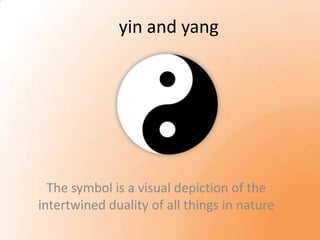
Yinyangwmov
- 1. yin and yang The symbol is a visual depiction of the intertwined duality of all things in nature
- 2. • Yin and Yang are dependent opposing forces that flow in a natural cycle, always seeking balance. Though they are opposing, they are not in opposition to one another. As part of the Tao, they are merely two aspects of a single reality. Each contains the seed of the other, which is why we see a black spot of Yin in the white Yang and vice versa. They do not merely replace each other but actually become each other through the constant flow of the universe.
- 3. Some examples of yin and yang
- 4. Does M. C. Escher inadvertently employ yin and yang in many of his works?
- 5. Yin and yang in art and nature
- 6. Inorganic yin and yang These erosion products of the Jacobsville Sandstone were collected from the Lake Superior shore north of Marquette, Michigan. The iron makes the sandstone red (yang) but with chemical change the color is bleached to yield the white spots (yin). Upon further chemical change the yin expands and the yang is expressed as red spots.
- 7. Organic yin and yang – grown in nature
- 8. Qigong Literally "Life Energy Cultivation") is a practice of aligning breath, movement, and awareness for exercise, healing, and meditation. With roots in Chinese medicine, martial arts, and philosophy, qigong is traditionally viewed as a practice to cultivate and balance qi (chi) or what has been translated as "intrinsic life energy”. Typically a qigong practice involves rhythmic breathing coordinated with slow stylized repetition of fluid movement, a calm mindful state, and visualization of guiding qi through the body. Qigong is now practiced throughout China and worldwide, and is considered by some to be exercise, and by others to be a type of alternative medicine or meditative practice. From a philosophical perspective qigong is believed to help develop human potential, allow access to higher realms of awareness, and awaken one's "true nature”.
- 9. QiGong (pronounced "chee gong" and alternatively spelled as "qigong," "qi gong," or "chi kung") is sometimes called “the new yoga” - but the practice dates back thousands of years to ancient China. The word “qi” (or “chi”) means “life force” or "vital energy of the body," and “gong” means accomplishment or skill that is cultivated through steady practice. Qi Gong is specifically designed to cultivate the body's vital energy, using it to heal and strengthen every system throughout the body. Thus, qi gong means “cultivating energy,” and it involves working with energy to strengthen and cleanse the body.
- 10. Confucianism Qigong provides a means to become a Junzi (君子) through awareness of morality. Taoism Qigong provides a way to achieve longevity and spiritual enlightenment. Buddhism Qigong is part of a spiritual path that leads to spiritual enlightenment or Buddhahood.
- 11. Qigong practitioners at World Tai Chi and Qigong Day event in Manhattan, New York City, USA.
- 12. Today, millions of people around the world practice qigong and believe in the benefits of qigong to varying degrees. Similar to its historical origin, those interested in qigong come from diverse backgrounds and practice it for different reasons, including for exercise, recreation, preventive medicine, self-healing, self- cultivation, meditation, and martial arts training.
- 13. The concepts of Yin and Yang and the Five Agents provided the intellectual framework of much of Chinese scientific thinking especially in fields like biology and medicine The organs of the body were seen to be interrelated in the same sorts of ways as other natural phenomena, and best understood by looking for correlations and correspondences. Illness was seen as a disturbance in the balance of Yin and Yang or the Five Agents caused by emotions, heat or cold, or other influences. Therapy thus depended on accurate diagnosis of the source of the imbalance.
- 14. The Five Agents are categories referring to the fundamental ingredients of the universe. They are named after wood, fire, earth, metal and water, but do not simply refer to these five concrete substances. Rather, they represent a basic framework or mental model by which all phenomena can be classified into five types. The Five Agents are the basic ingredients of the universe.
